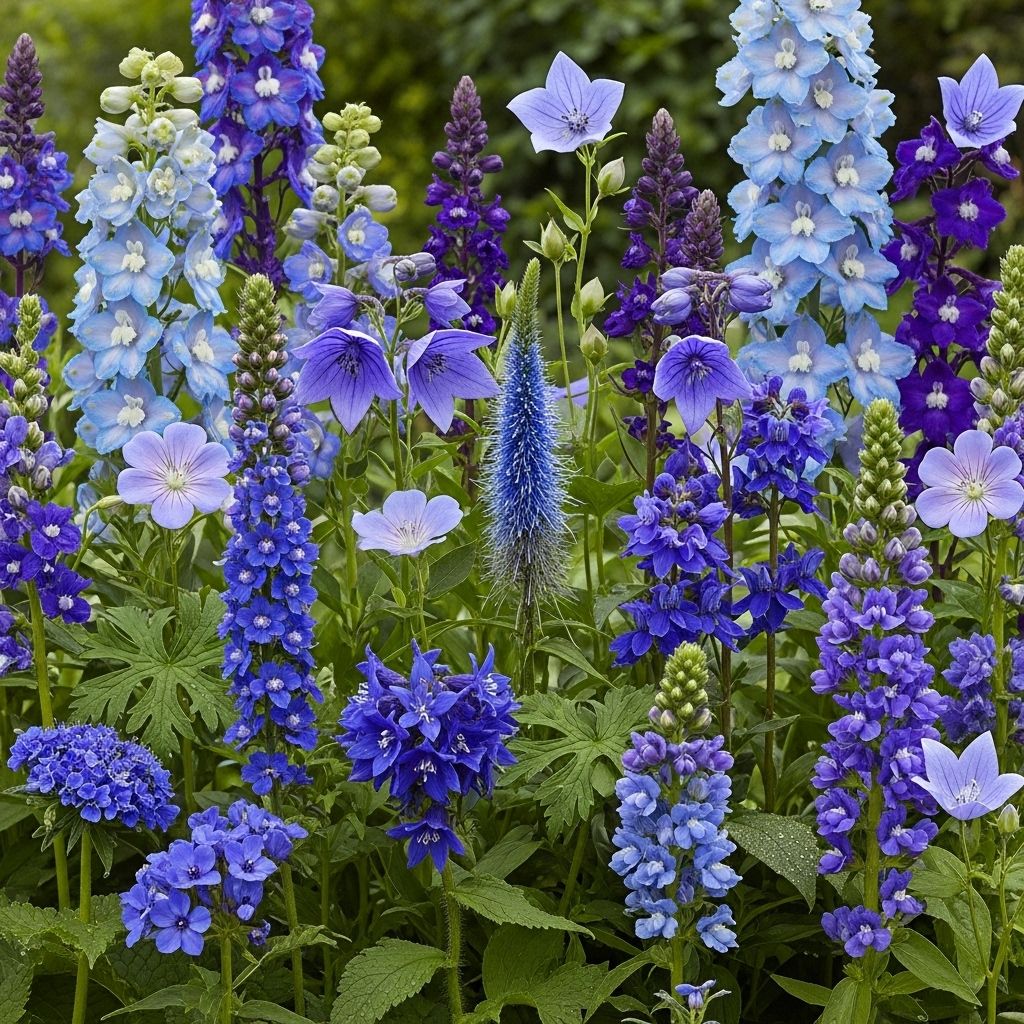21 Stunning Blue Perennial Flowers: Names, Photos & Growing Guide
Effortless options for year-after-year blooms that suit any style and soil condition.

Image: HearthJunction Design Team
21 Stunning Blue Perennial Flowers to Transform Your Garden
Blue perennial flowers evoke tranquility and add unique depth to garden landscapes, pairing beautifully with a wide range of colors and garden styles. In this comprehensive guide, discover 21 standout blue perennials—from timeless classics to unique cultivars—alongside their key features, care requirements, and design suggestions. Whether you crave bold indigo spikes or delicate pale hues, each flower offers a way to brighten your perennial beds with captivating blues year after year.
Why Choose Blue Perennial Flowers?
Blue is a comparatively rare color in the plant world, making blue perennials a distinctive addition to any landscape. These flowers can:
- Create cool, calming areas in mixed borders
- Attract pollinators such as bees and butterflies
- Provide continuity and structure as they return each season
- Combine well with contrasting warm colors for a dramatic effect
- Thrive in various climates and garden settings when chosen thoughtfully
21 Blue Perennial Flowers: Names and Descriptions
Below, we detail 21 reliable blue perennials, highlighting key growing information, visual features, and ideal uses in the landscape. Pair several together for a mosaic of beautiful blues spanning the growing season.
1. Bluebells (Hyacinthoides spp.)
Bluebells emerge in early spring, carpeting shady woodlands with delicate blue to violet, bell-shaped blooms. Grown from hardy bulbs, they tolerate cold and thrive in partial shade, making them wonderful for naturalizing beneath trees.
- Bloom Time: Spring
- Preferred Conditions: Moist, well-draining soil; partial shade
- Design Tip: Plant en masse for a true woodland effect
2. Blue Delphinium (Delphinium grandiflorum)
These towering spikes of blue blooms create vertical interest and drama, especially in cottage gardens. Make sure to provide supports, as mature plants can get top-heavy.
- Bloom Time: Early to midsummer
- Preferred Conditions: Full sun to part shade, fertile moist soil
- Care: Stake taller varieties for support; deadhead for longer display
3. Blue Star (Amsonia tabernaemontana)
The blue star features clusters of soft blue, star-shaped flowers above bushy green foliage. Low-maintenance and adaptable, it shines in mixed borders and attracts a variety of pollinators.
- Bloom Time: Late spring to early summer
- Preferred Conditions: Full sun to partial shade; average, well-drained soil
- Notable: Golden fall foliage adds multi-season interest
4. Blue Mistflower (Conoclinium coelestinum)
Blooming in late summer and fall, blue mistflower produces clouds of pale blue flowers beloved by butterflies. This perennial is ideal for extending color in the landscape after many other plants have faded.
- Bloom Time: Late summer to fall
- Preferred Conditions: Moist, well-drained soil; part shade to sun
- Design Tip: Use in wildflower meadows or along borders for a naturalistic feel
5. Blue Flax (Linum perenne)
Blue flax offers delicate, sky-blue blooms on wispy stems from spring to summer. Tolerant of drought, heat, and poor soil, it is excellent for low-maintenance borders and wildflower plantings.
- Bloom Time: Spring to summer
- Preferred Conditions: Full sun to part shade; well-drained soil
- Feature: Flowers open each morning and fade by evening, but new blooms appear daily
6. Gentian (Gentiana spp.)
Renowned for their intense blue trumpet-shaped flowers, gentians bloom in late summer and autumn. Choose varieties suited to your climate, as some prefer alpine conditions.
- Bloom Time: Late summer to autumn
- Preferred Conditions: Moist, acidic, well-drained soil; partial shade
- Design Tip: Ideal for rock gardens and woodland edges
7. Blue Monkshood (Aconitum napellus)
Featuring tall spikes of deep blue helmet-shaped flowers in mid-late summer, monkshood is striking but toxic—plant with care away from children and pets.
- Bloom Time: Midsummer to fall
- Preferred Conditions: Moist, fertile, well-drained soil; partial shade
- Safety: Always wear gloves when handling—it’s very poisonous if ingested
8. Salvia (Salvia nemorosa and related species)
Salvias are versatile perennials with upright spires of violet-blue flowers. Perfect for attracting bees and hummingbirds, they’re resilient and long-blooming.
- Bloom Time: Late spring to fall
- Preferred Conditions: Full sun; well-drained soil
- Care: Remove spent spikes to encourage repeat flowering
9. Siberian Iris (Iris sibirica)
Siberian irises combine slender, grass-like foliage with elegant blue to purple blooms. Naturally deer-resistant and easy to grow.
- Bloom Time: Late spring to early summer
- Preferred Conditions: Sun to part shade; moist, well-drained soil
- Usage: Beautiful in borders and alongside ponds or streams
10. Blue Globe Thistle (Echinops ritro)
Striking spherical blue flower heads distinguish the globe thistle. Low maintenance, drought-tolerant, and attractive to pollinators.
- Bloom Time: Summer
- Preferred Conditions: Full sun; well-drained soil
- Feature: Excellent for dried flower arrangements
11. Virginia Bluebells (Mertensia virginica)
Virginia bluebells enchant with clusters of sky-blue, bell-shaped flowers in spring. They die back by midsummer, making them ideal for planting among later-blooming perennials.
- Bloom Time: Early to mid-spring
- Preferred Conditions: Partial to full shade; moist, rich soil
- Design Tip: Pair with hostas or ferns for continuous coverage
12. Baptisia (Baptisia australis)
Also called blue false indigo, baptisia bears spikes of deep blue flowers and attractive foliage. Adaptable and long-lived.
- Bloom Time: Late spring to early summer
- Preferred Conditions: Full sun; well-drained soil
- Notable: Forms shrub-like clumps with attractive seed pods
13. Brunnera (Brunnera macrophylla)
Brunnera produces sprays of small blue, forget-me-not-like flowers above large, heart-shaped leaves—ideal for part-shade gardens.
- Bloom Time: Spring
- Preferred Conditions: Shade to part shade; moist, rich soil
- Notable: Foliage provides long-lasting texture even after flowering
14. Blue Marguerite Daisy (Felicia amelloides)
This cheerful perennial features sky-blue petals around a sunny yellow center, creating a striking contrast in garden beds and containers.
- Bloom Time: Spring to fall
- Preferred Conditions: Full sun; well-drained soil
- Tip: Deadhead regularly to prolong blooming period
15. Blue Corydalis (Corydalis flexuosa)
Valued for its vivid blue tubular flowers, corydalis tolerates shade and blooms on and off throughout the growing season, especially in cooler climates.
- Bloom Time: Spring and sporadically through summer
- Preferred Conditions: Part to full shade; moist, well-drained soil
- Design Idea: Plant along woodland paths for a naturalistic look
16. Blue Veronica (Veronica spicata)
This easy-care perennial shows off narrow spikes of blue flowers and is great for borders or as a cut flower.
- Bloom Time: Early to midsummer
- Preferred Conditions: Full sun to part shade; well-drained soil
- Care: Remove finished flower spikes for reblooming
17. Blue Balloon Flower (Platycodon grandiflorus)
Named for their unique balloon-shaped buds that pop open into starry blue flowers, balloon flowers are whimsical additions to mixed borders.
- Bloom Time: Mid to late summer
- Preferred Conditions: Full sun to part shade; well-drained soil
- Maintenance: Very low; stems can be pinched back to encourage bushier growth
18. Lithodora (Lithodora diffusa)
This compact perennial forms mats of evergreen foliage covered in intensely vivid blue flowers. It’s ideal for edging paths and filling rocky spaces.
- Bloom Time: Spring to early summer
- Preferred Conditions: Full sun; well-drained, acidic soil
- Design Tip: Use in rock gardens or containers for best effect
19. Jacob’s Ladder (Polemonium caeruleum)
A classic cottage garden perennial, Jacob’s Ladder delivers clusters of blue, bell-shaped flowers atop divided foliage.
- Bloom Time: Late spring to early summer
- Preferred Conditions: Part shade; moist, fertile soil
- Care: Cut back after flowering to promote fresh foliage
20. Blue False Indigo (Baptisia australis)
This tall, shrub-like perennial blooms with deep blue pea-shaped flowers and is drought-tolerant once established.
- Bloom Time: Late spring to early summer
- Preferred Conditions: Full sun; well-drained soil
- Benefit: Fixes nitrogen, improving garden soil
21. Nepeta (Nepeta faassenii – Catmint)
Nepeta is a prolific bloomer with abundant lavender-blue flowers and aromatic foliage—excellent for pollinators and as an easy groundcover.
- Bloom Time: Late spring to fall
- Preferred Conditions: Full sun to part shade; dry to average soil
- Design Idea: Softens the border edge beautifully and pairs well with roses
Design Tips for Blue Perennial Gardens
- Contrast with warm colors: Pair blue flowers with yellows, oranges, or reds for enhanced visual impact.
- Layer heights and textures: Mix tall spires with mounding or groundcover species to create dimension.
- Vary bloom times: Combine early, midsummer, and late bloomers for season-long blue color.
- Use as focal points or accents: Tuck just a few blue-flowering perennials into existing plantings or go bold with a monochromatic blue theme.
| Flower | Main Bloom Time | Sunlight | Water Needs | Height |
|---|---|---|---|---|
| Delphinium | Early to midsummer | Full Sun | Medium | 3-6 ft |
| Blue Star | Late spring to early summer | Full/Part Sun | Low | 2-3 ft |
| Blue Mistflower | Late summer to fall | Sun/Part Shade | Medium | 1-2 ft |
| Blue Flax | Spring to summer | Full Sun | Low | 18-30 in |
| Gentian | Late summer to autumn | Part Shade | Medium | 6-12 in |
Frequently Asked Questions (FAQs)
Q: Can blue perennial flowers attract bees and butterflies?
A: Yes, many blue perennials such as salvia, delphinium, blue mistflower, and bluebells are especially attractive to pollinators, supporting beneficial insects in your landscape.
Q: Are blue perennials difficult to care for?
A: Most blue perennials are low-maintenance once established. Choosing species suited to your climate and soil type is key; many, like salvia and baptisia, are drought-tolerant, while others, like brunnera, prefer moist shade.
Q: Which blue perennials bloom the longest?
A: Salvia, nepeta (catmint), and blue flax all flower over extended periods. Deadheading can encourage repeat blooming in many varieties.
Q: How do I combine blue perennials for season-long color?
A: Choose a mix of early (e.g., bluebells, brunnera), midseason (e.g., delphiniums, veronica), and late-blooming (e.g., blue mistflower, gentian) varieties. Stagger planting within beds so something blue is always in flower.
Q: Are there blue perennials for full shade?
A: Yes, options like brunnera, blue corydalis, and Virginia bluebells thrive in shady woodland areas, providing brilliant blue hues even where sunlight is limited.
References
- https://www.epicgardening.com/blue-mistflower/
- https://www.epicgardening.com/blue-perennial-flowers/
- https://www.waltersgardens.com/photo_essay.php?ID=423
- https://shop.epicgardening.com/products/blue-and-breezy-flax-seeds
- https://www.pinterest.com/pin/21-blue-perennial-flowers-with-names-and-pictures-in-2023–130252614216283381/
Read full bio of medha deb












